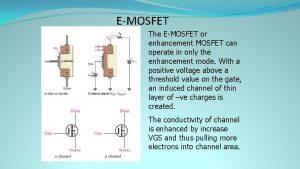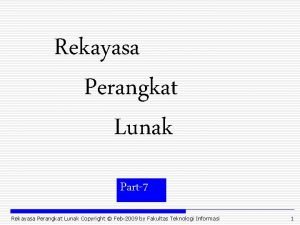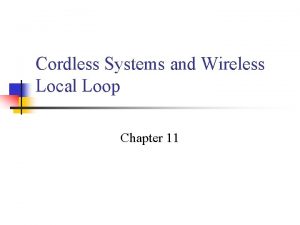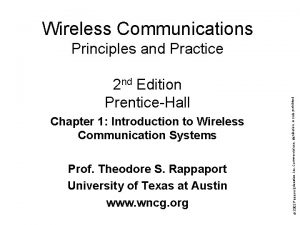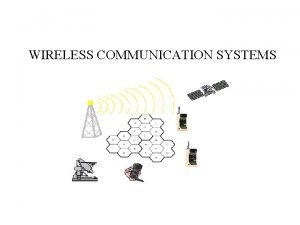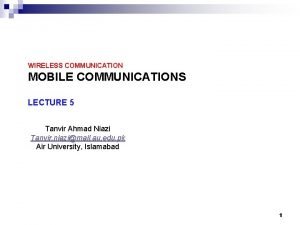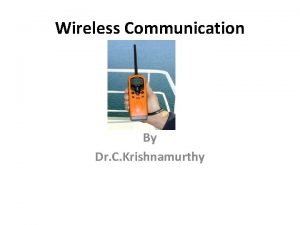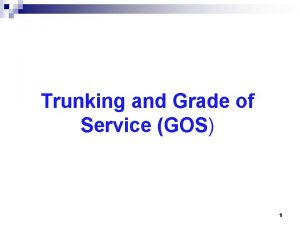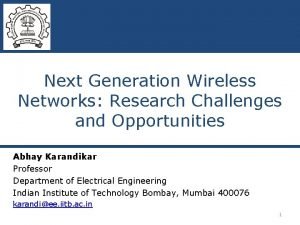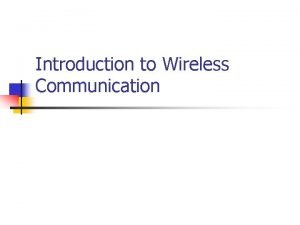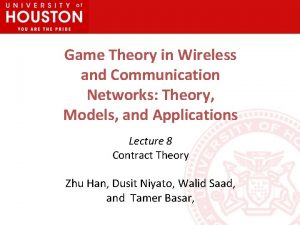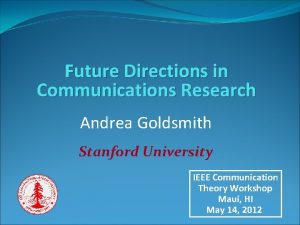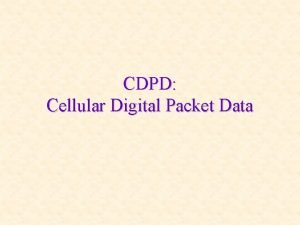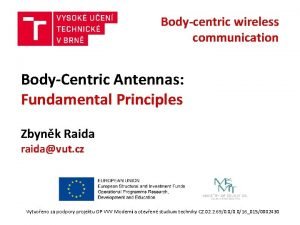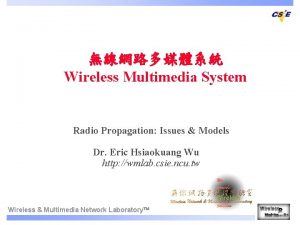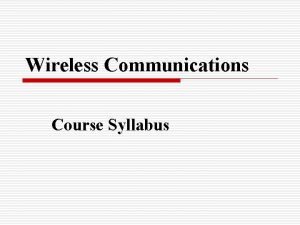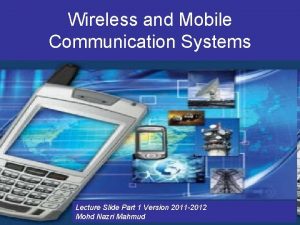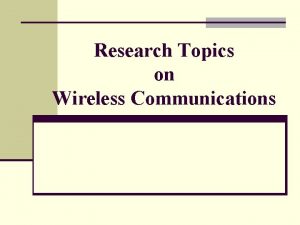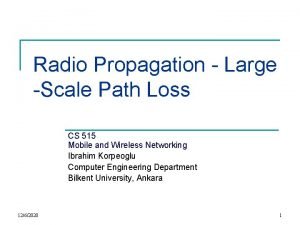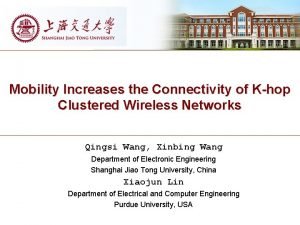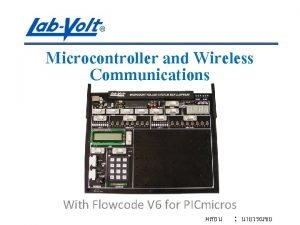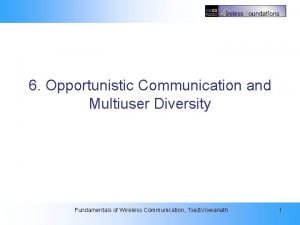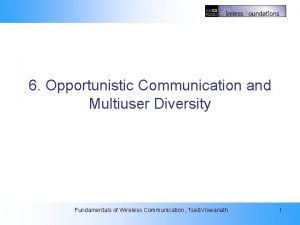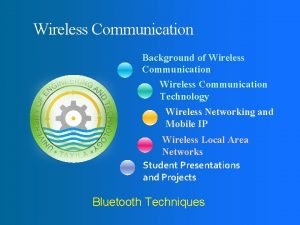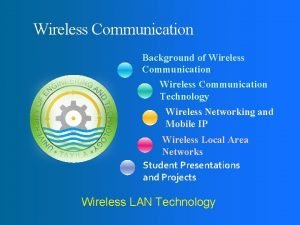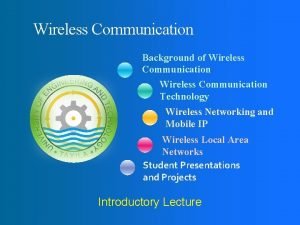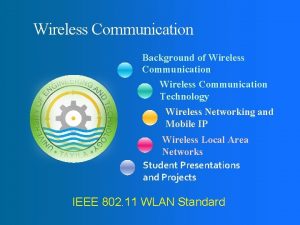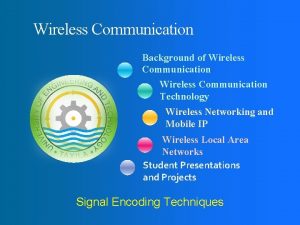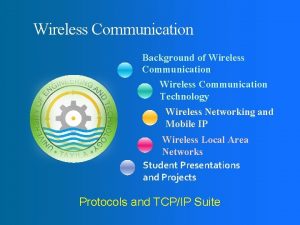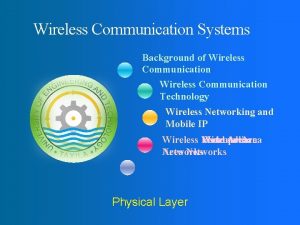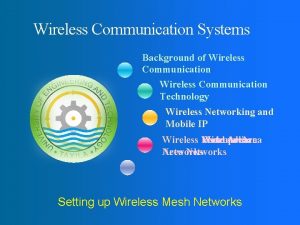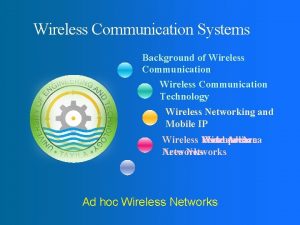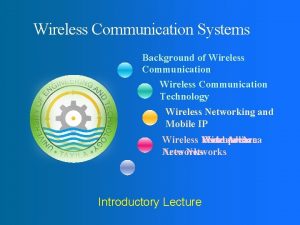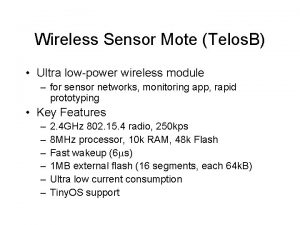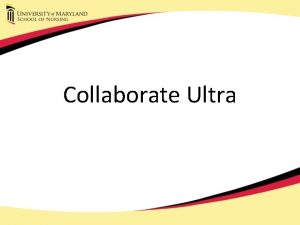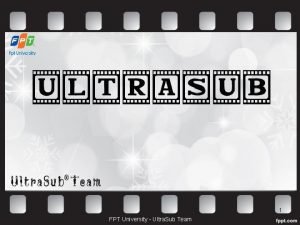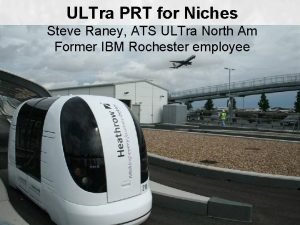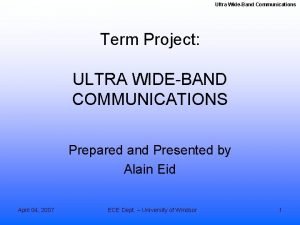Can Opportunistic Wireless Communication Systems operate at ultra



























- Slides: 27

Can Opportunistic Wireless Communication Systems operate at ultra low power and deliver Quality of Service? "Future Telecommunications: Regulated or Self-Organized? “ Jean-Paul Linnartz Senior Technology Director, Philips Research

Outline • Paradigms governing Radio Communication – Noise limitations – Interference Limitations – Power Limitations • Examples – Interference cancellation – Receive power-limited systems – Heterogeneous traffic in ISM bands • Concluding Observation Philips Research 2

1904 – 2008 Radio Communication, a field with tremendous innovation 1904: Marconi proudly communicated across. the Atlantic Ocean. 2008: we proudly invent new wireless systems that cover a few meters Philips Research 3

Many electronic devices will incorporate body sensors Body Sensors will accompany us from the baby cradle to the elderly care home Baby - Toddler - Child - Teen - Young Adult - Parent – Mid Aged Adult - Senior Philips Research 4

The ambient Information superhighway Toward an homogeneous communication infrastructure 1 Global network 103 MANs 106 Macrocells 106 LANs 107 WLAN nodes 108 access links 109 personal trusted devices 109 PANs 1011 Sensor nodes • The dream: One network connects 1010 people and 1012 sensor nodes. • The reality: an explosion of different, incompatible and mutually interfering standards 1993 Philips Research 5

Bitrates span many orders of magnitude • Our wireless systems need to connect sensors @ a few bits/minute up to real-time gaming and medical imaging @ multigigabits/sec Ultra low power 10 k 100 k • 1 M Interference mitigation 10 M 100 M • 1 G Speed race 10 G Wireless Data Rate (bit/s) Philips Research 6

Exponential Growth of Communication Traffic The pace of innovation in the semiconductor market follows Moore’s law. Communication was believed to grow slower because of limited spectrum availability. Nonetheless the total traffic carried by radio transmission has grown with exponents much higher than those of semiconductor chips. Philips Research 7

Exponential law on radio connectivity • Exponent consists of a number of terms: – – Higher carrier frequencies Denser reuse More efficient signal handling More efficient traffic assignment per channel • Each term has a succession of technologies that provided growth in innovation waves: – – – FM radio allowed denser reuse Cellular telephone optimized reuse according to interference constraints Diversity CDMA telephone allowed reduction of fade margins Directional antenna’s – Digitization of speech – Multi-user communication and Interference cancellation – MIMO – Trunking – Random Access protocols, ALOHA – Cognitive radio Philips Research 8

Paradigm shifts Noise-Limited Transatlantic Morse Channel-Limited Diversity Channel equalizers Rake Receiver OFDM Doppler Compensation Interference-Limited FM – CDMA – cellular – MIMO Cognitive radio Philips Research Battery power Limited Adaptive front ends Pulsed UWB, Wake-up radio 9

The battle against nature / culture • “Civilizations initially learn how to handle nature, later their biggest concern is how organize their culture” • The key challenge in interference-limited radio systems is to avoid noise enhancement • What comes after the era of the interference-limited paradigm? Philips Research 10

70’s and 80’s: Spectrum is very scarce but broadcast networks were planned using a noise-limited paradigm Interference protection of cable networks against radio pirates, Scheeren, P. ; Arnbak, J. Communications Magazine, IEEE, Volume 25, Issue 4, Apr 1987 Page 7 - 17 Philips Research 11

Noise enhancements • The noise-enhancement is the main reason why the signal processing community had so much success in applying their concepts in wireless communication Philips Research 12

Field stength Broadcast Planning Distance Noise-limited CCIR planning Curves Interference Limited Cell planning. Adjacent channel occupancy was a major concern. Philips Research 13

Observation: Cellular reuse is not effective for data Queueing delay for packet transmission in a cellular packet-switched system versus traffic carried per cell. Various reuse patterns. Cosine Group Xiangyu Wang 01 -06 -2005 Philips Research 144

Spectrum Agile/Cognitive Radios • Spectrum allocated, but much of it is unused (“white space”) • Agile radios harness white space • 10 x more access to spectrum Philips Research Source: Shared spectrum company funded by NSF 15

What is Cognitive Radio? radio systems that learn about the utilization of the radio spectrum, by itself and from others collaboratively, and • adaptively adjust their operating behavior • in order to achieve high throughput, reliability, … • through autonomous and distributed interference handling Philips Research 16

Example: Interference in MAC protocols • Ready to Send - Clear to Send (RTS - CTS) is a virtual carrier sense mechanism. • Practical implementations, e. g. 802. 11 e, have performance issues • Too conservative in reserving radio resources Homogenous arrival rate 0. 3 0. 25 0. 2 0. 15 0. 1 0. 05 0 2 Tx Rx 1 0 -1 -2 -2 2 1 0 -1 (Conditional) capture probability • Intermediate Result a priori (__) and a posteriori (. . ) capture probability for potential interferers. Non-homogenous arrival rate 0. 4 0. 3 0. 2 0. 1 0 2 1 1 0 -1 -2 Philips Research Credit: Chin Keong Ho, TU/e -1 0 -2 17 2

Coexistance of low power sensor nodes and high power WLAN signals are much stronger that Zigbee Signals WLAN transmitters can rapidly access the channel when idle WLAN traffic blocks all BSN traffic, unless special precautions are taken Cross-standard Cooperative protocols: A fake WLAN handshake can silence all WLAN traffic for a short period. Philips Research 18

Quality of Service in the Radio Spectrum • The WLAN in ISM band concept triggered an explosion of activities in wireless connectivity • Increasingly large portions of the spectra will be used by multiple coexisting systems, applying cognitive radio concepts But, . . . it becomes increasing difficult obtain medical-grade wireless connectivity – The allocation of dedicated bands is not favored – Dedicated solutions are economically not viable, as alternative massmarket solutions follow rapid innovation and steep price erosion – The IT departments choose for IT–friendly solutions, i. e. , IEEE 802. 11 a/b/g/n WLAN, which has minimal Qo. S quarantees Philips Research 19

Can Opportunistic Wireless Communication Systems deliver Quality of Service? Cognitive, opportunistic radio nodes operate in shared bands with many potential interferers, - Belonging to same or to different networks Use the same channel, partially overlapping or neighboring channels Using the same, a different or even an known standard Use similar or widely different traffic properties Use similar or widely different communication ranges and power levels Operate using a distributed or coordinated management Friendly, cooperative, civilized, selfish, non-cooperative, malicious How can one guarantee Quality of service? Philips Research 20

Can Opportunistic Wireless Communication Systems operate at ultra low power? Cognitive, opportunistic radio may consume large amounts of power • Operation in an interference-limited regime, hence requirements to RF receivers may lead to high power consumption • Monitoring of the radio channel (power levels, extracting cyclostationary statistical properties ) • Determining a smart strategy, requires gathering information Philips Research 21

Listening consumes more power than talking Shannon: Eb/N 0 “communication theory is TX power centric” Stand-bye, hibernating or sleeping Amplifying and filtering incoming signals Detecting an incoming signal Synchronizing Channel estimation Digitizing analog signals Checking addressing Cancelling interference … New RX power centric paradigms are needed for system design Philips Research 22 22

Low power receiver design challenge PR= PLNA + PMix + PFil PLNA PMix PFil 23 LNA A/D Mixer Filter What is the best circuit power allocation in order to achieve the highest information throughput (bits) per Joule of energy consumed in the receiver ? Philips Research 23

Throughput (bit/s) per Joule Throughput per Joule that a receiver can achieve while consuming a certain circuit power CIR = -10 d. B Continuous circuit power assigned to receiver, optimally distributed over various stages Philips Research Credit: Johan van den Heuvel, TU/e 24

Conclusion Future Telecommunications: Self-Organizing, thus highly regulated Philips Research 25

Philips Research

Can Opportunistic Wireless Communication Systems operate at Ultra Low Power and deliver Quality of Service? • Historically, radio spectrum has been seen as a scarce resource that was sparsely used. However, the opening up of the ISM bands for unlicensed WLAN communication suddenly triggered a tremendous industrial growth. Moreover, recently developed cognitive radio concepts allow an opportunistic way of accessing the spectrum, with great liberty in frequency bands, modulation schemes, and multipleaccess methods. In this presentation, these developments are discussed in the context of other trends. Wireless systems are increasingly used for life and mission critical applications while unlicensed and cognitive radio approach cannot fulfill Qo. S requirements. Further, as we deploy very dense radio networks operating only over short ranges, the receiver circuit power rather than the transmit amplifier power consumption dominates the battery life time of portable radio nodes. It challenges the traditional Eb/N 0 optimization, which was the leading paradigm since Shannon in 1948. Philips Research 27
 What are wireless devices and the wireless revolution
What are wireless devices and the wireless revolution E-mosfet can operate in
E-mosfet can operate in Ethan can operate his camera with only one hand
Ethan can operate his camera with only one hand Opportunistic infections
Opportunistic infections Opportunistic infections
Opportunistic infections Opportunistic approach adalah model proses
Opportunistic approach adalah model proses Designing language curriculum
Designing language curriculum Retroviruses and opportunistic infections
Retroviruses and opportunistic infections Ul nurse call system testing
Ul nurse call system testing Wireless local loop architecture
Wireless local loop architecture Wireless communication introduction
Wireless communication introduction Paging wireless communication
Paging wireless communication Cell dragging in mobile communication
Cell dragging in mobile communication Advantages of wireless communication
Advantages of wireless communication What is trunking and grade of service
What is trunking and grade of service Next generation wireless communication market
Next generation wireless communication market Advantages of wireless communication
Advantages of wireless communication Game theory in wireless and communication networks
Game theory in wireless and communication networks Andrea j. goldsmith
Andrea j. goldsmith Cdpd
Cdpd Fundamental principles of wireless communication
Fundamental principles of wireless communication Free space propagation model in wireless communication
Free space propagation model in wireless communication Wireless communication course syllabus
Wireless communication course syllabus Large scale fading in wireless communication
Large scale fading in wireless communication Wireless communication research topics
Wireless communication research topics (y+z)p+(z+x)q=x+y
(y+z)p+(z+x)q=x+y Free space propagation model in wireless communication
Free space propagation model in wireless communication Microcontroller wireless communication
Microcontroller wireless communication

